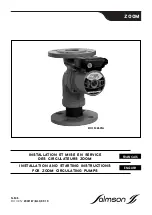
6 720 608 034
Installation instructions
11
3.7
Gas piping & connections
Before connecting the gas supply, check the rating
plate on the right side of the heater to be sure that the
heater is rated for the same gas to which it will be
connected.
In the United States: The installation must conform with
local codes or, in the absence of local codes, the
National Fuel Gas Code ANSI Z223.1/NFPA 54.
In Canada: The Installation should conform to CGA
B149 INSTALLATION CODES and/or local installation
codes.
Mount regulator to gas inlet pipe as shown in Fig. 13.
The arrow on the back of the regulator indicates the
direction of gas flow and should point toward the
appliance.
Fig. 13 Installation of Gas Pressure Regulator
Note
: The GWH 425 PN
comes with a gas pressure
regulator. Not installing or altering the gas pressure reg-
ulator will be a violation of CSA certification of the unit.
The regulator supplied with the heater is preset for the
gas shown on the rating plate to the correct pressure. It
is an appliance level regulator designed for (low inlet)
pressure (less than 1/2 Psig or 14" W.C.).
GAS CONNECTIONS
B
Install a manual gas shut off valve, on the gas supply
line.
B
Install a union when connecting gas supply.
B
Attach the appliance regulator to the inlet gas pipe.
B
The minimum diameter required for any appliance
connector used is ¾”.
B
National Fuel Gas Code requires that a sediment
trap (drip leg) be installed on gas appliances not so
equipped. The drip leg must be accessible and not
subject to freezing conditions. Install in accordance
with the recommendations of the serving gas
supplier.
When connections are made, check for gas leaks at all
joints. Apply some gas leak detection solution to all gas
fittings. Bubbles are a sign of a leak. A combustible gas
detector may also be used to detect for leaks.
HIGH ALTITUDE INSTALLATION
The pressure regulator provided with the heater is
adjusted to deliver the proper gas pressure (as
indicated on the rating plate and in the manual for
altitude up to 2000 feet (660 meters) above sea level.
On appliances being installed above 2000 ft (660
meters) elevation, the inlet gas pressure should be set
at installation to the value shown below.
Note:
The gas pressures specified below refer to
pressures taken at the pressure tap on the gas inlet pipe
just above the regulator. See chapter 3.8 for measuring
gas pressure.
MAXIMUM INLET GAS FLOW PRESSURE SETTING
GAS LINE SIZING
The gas supply piping should be sized according to the
applicable code for a maximum draw of 117,000 BTUH.
Measure the length of gas supply line and use the tables
in Fig. 14 or the gas line manufacturer’s sizing tables to
determine the pipe diameter necessary to
accommodate the BTU demand of the unit. If there are
more gas appliances drawing on the same line, size the
gas line according to the total maximum amount of BTU
draw for all appliances.
Note:
Under sizing the gas line may result in diminished
output and improper operation. See chapter 3.8 for the
procedure to confirm gas pressure.
Warning:
DO NOT connect to an
unregulated or high pressure propane
line or to a high pressure commercial
natural gas line.
Warning:
The heater must be isolated
from the gas supply piping system
during any pressure testing of that
system at test pressures equal to or
more than 0.5 psig. If overpressure has
occurred, such as through improper
testing of the gas lines or malfunction of
the supply system, the gas valve must
be checked for safe operation.
Danger:
If you have a leak, shut off the
gas. Tighten appropriate fittings to stop
leak. Turn the gas on and check again
with a gas leak detection solution.
Never test for gas leaks using a match
or flame.
Altitude
Nat. Gas
inches W.C.
Liquid Propane
inches W.C.
0’ - 2 000 ft
5.7”
10.5”
2 000 ft - 4 500 ft
4.6”
8.4”
Table 3 Above 4.500 ft consult your local gas provider












































